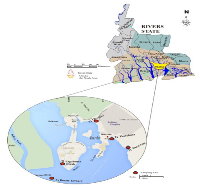Bio-accumulation of Pb and Cd in the Soft tissues of Tympanotonous fuscatus, Sediment quality of the Upper Bonny Estuary Niger Delta and their Human Health Implications
Keywords:
Lead, Cadmium, sediment quality, Tympanotonus fuscatus, health risksAbstract
Environmental Pollution is a global problem especially as it affects the human health. Appreciable levels of heavy metals in the ecosystem exert deleterious effects on plants, animals and humans due to their high level of toxicity, persistence and bioconcentration and transfer along the food chain. So, studies to bio-monitor the levels of heavy metals in the environment and determine potentially hazardous levels for humans are necessary. In this study the concentration of Pb and Cd in the soft tissues of Typanotonous fuscatus and sediment quality of the upper Bonny Estuary, Niger Delta was carried out. Samples of Tympanotonous fuscatus were caught in 5 selected stations namely; Okochiri Creek (S1), Ekerekana Creek (S2), Okari-Ama Creek (S3), Ogoloma River (S4) and Bonny Estuary (Control). Concentrations of Pb and Cd in the soft tissues of Tympanotonous fuscatus and Sediment were analyzed following standard procedures using atomic absorption spectrophotometer (AAS) by GBC Avanta. The concentration of Pb and Cd in the soft tissues of Tympanotonous fuscatus ranged from 11.49 to 15.42mg/kg and 0.06 to 0.13mg/kg respectively, these values were not significantly different using turkeys multiple comparison at P<0.05 amongst the sampled stations. The concentrations of Pb were higher than the FAO permissible limit of 0.5mg/kg while Cd was below permissible limit. However, the Estimated Daily Intake (EDI) showed that Pb concentration ranged from 6.57mg/kg to 8.81mg/kg which is above FAO/WHO,(2010) Permissible Tolerable Daily Intake of 0.25mg/kg while estimated daily intake for Cd showed the range of 0.01 to 0.07mg/kg, which were within FAO / WHO, (2010) Permissible Tolerable Daily Intake of 0.07mg/kg. Sediment concentration range of 6.13 to 11.66 mg/kg and 0.01mg/kg to 0.07mg/kg were recorded for Pb and Cd respectively. These levels were below sediment quality guideline of 40mg/kg and 1mg/kg respectively (USEPA, 1999). The results above indicated that consumption of Tympanotonous fuscatusfrom the sampled areas of Upper Bonny Estuary would likely pose a potential health risk because of the high concentration of Pb which could bio-accumulate in the soft tissues and bones of the consumer, further more the sediment quality also revealed that Pb and Cd in sediment of the sampled stations were below permissible limit as specified by USEPA, SQG (1999) indicating them not to be up to pollution levels. This study emphasized that due to continuous exposure of the study area to industrial effluent discharges into the water bodies, over time, the accumulation of Pb and Cd in sediment and soft tissues of Tympanotous fuscatus could increase and become very detrimental for the coastal area. This will then constitute a health risk to the individuals in the area that consume these organisms and definitely become an issue of serious environmental concern.
Downloads
References
Ademoroti, C.M.A. (1996). Standard methods for water and effluent analysis. Foludex Press Ltd, Ibadan. 182pp.
American Public Health Association (APHA) (1998).Standard Methods for the examination of water and waste water, 20th edition. Washington DC,USA pp. 1244.
Bob-Manuel, F. G. (2012). A preliminary study on the population estimation of the periwinkle Typanotonous fuscatus (Linnaeus, 1758) and
Pachymelania aurita (Muller) at the Rumuolumeni mangrove swamp creek, Niger Delta, Nigeria. Agriculture and Biology Journal of North America. 3(6): 265-270.
Burger, J., and Gochfeld, M. (1997). Lead and neurobehavioural development in gulls: a model for understanding effects in the laboratory and field. Neurotoxicology 18: 495-506.
Camusso, M., Vigano, L., Baitstrini, R.(1995). Bioaccumulation of trace metals in rainbow trout. Ecotox. Environ. Safe., 31: 133-141.
Dambo, W.B., and Ekweozor, I.K.E.(2000). The determination of lead in mangrove oyster, Crassostreagasar from the lower bonny estuary, Nigeria.J. Appl. Sci. Environ. Mgt., 4:101-108.
Eisler, R. (1988). Lead hazards to fish, wildlife, and invertebrates: a synoptic review. US Fish and Wildlife Service Report No. 85(1.14), Washington, DC.
FAO. Compilation of legal limits for hazardous substances in fish and fishery products. Rome: Food and Agriculture Organization; 1983. p. 5-100.
FAO/WHO (2010). Summary report of the seventy third meeting of JECFA. Joint FAO/WHO Expert Committee on Food Additives. Geneva.
IAEA (International Atomic Energy Agency). 2003. Trace elements and methyl mercury in fish. International Atomic Energy Agency Austria 407: 1–4. Available at http://www.iaea.org/nael/refmaterial/iaea407.pdf
Jamabo, N., and Chinda, A. (2010). Aspects of the Ecology of Tympanotonous fuscatus var fuscatuis (Linnaeus, 1758) in the Mangrove swamps of the Upper Bonny River, Niger Delta, Nigeria. Current Research journal of Biological sciences, 2(1):42-47
Maximilian, O. O., Josiah, C. O., and Chigozie, D. E. (2015). Trace metal contamination in tropical endemic fish: Factorial effect interactions and in situ quantitative risk assessment. Journal of Environmental and Occupational Science.
Monday, U.E., and Nsikak U.B. (2007). Cadmium, copper, lead, and zinc tissue levels in Bonga shad (Ethmalos afimbriata) and Tilapia (Tilapia guineensis) caught from Imo River, Nigeria. American Journal food Technolvol2 (1): 48 – 54.
Otitoloju, A.A., and Don-Pedro, K. N. (2002). Bioaccumulation of Heavy metals (Zn, Pb, Cu and Cd) by Tympanotonus fuscatusvar radula (L.)
exposed to sublethal concentrations of test metal compounds in laboratory bioassays. W. Afr. J. Appl. Ecol. 3: 17-29
Prosi, F. (1989). Factors controlling biological availability and toxic effects of lead in aquatic organisms: The Science of the Total Environment 79: 157-169
Ugbomeh A. P., and Bako, S. (2015). Heavy Metals (cadmium and lead) in the estuarine croaker, pseudotolithus elongatus from Port Harcourt, Nigeria. Journal of Aquatic Sciences 30 Association for Aquatic Sciences of Nigeria (ISSN: 0189-8779) http//www.journalofaquaticsciences.com (1B):173-180.
USEPA (1999). “US Environmental Protection Agency: Screening Level Ecological Risk Assessment Protocol for Hazardous Waste Combustion facilities,” Appendix E: Toxicity Reference values, Vol.3,
Zheng, X., Ding, Z., Xu, Y., Monroing, O., Morais, S., and Tocher, D.R.(2009). Physiological roles of fatty acyl desaturase and elongaseinmarine fish: Characterisation of cDNAs of fattyacyl Δ6 desaturase and Elov 15 elongase of cobia (Rachycentron canadum). Aquaculture, 290:122-131

Downloads
Published
Issue
Section
License

This work is licensed under a Creative Commons Attribution-NonCommercial-ShareAlike 4.0 International License.







